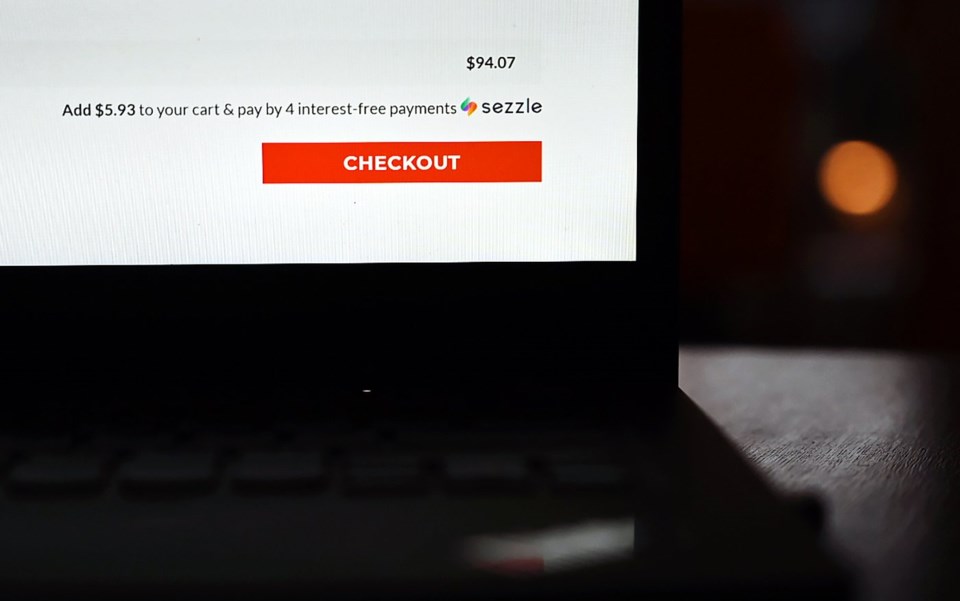TORONTO — When any service is offered for free, it’s good to know why.
In the booming market of buy now pay later financing, those opting in generally get to spread payments over a number of weeks at no cost, because it’s the merchants that pay for the service in the hopes it will convince consumers to spend more.
That’s certainly the promise providers like Affirm and Klarna advertise to businesses, touting 20-something per cent boosts to order totals, while Shopify says its instalment program can lead to up to a 50 per cent boost in average order value, plus up to 28 per cent fewer abandoned carts.
While the option can add convenience at possibly no direct cost to consumers, financial experts warn it’s far from risk free.
“The temptation is very great to overspend,” said insolvency trustee Doug Hoyes.
With the option popping up during online checkout, or –°¿∂ ”∆µ offered by a cashier, consumers are also not necessarily fully thinking through the decision, and the implications of what they‚Äôre agreeing to, said Hoyes.
“For the vast majority of people, you are taking on debt without really realizing it. You're not making a conscious decision that yes, I will borrow that money. And that's dangerous, obviously.”
While the vast majority of buyers pay off those debts — which tend to run in the hundreds of dollars rather than the thousands — there’s also a rising push to have the data shared with credit-reporting agencies, creating new areas of risk.
Just last week in the U.S., reporting giant FICO said it was launching its first credit scores that incorporate BNPL data.
And in April, Affirm said it would start sharing data with TransUnion in the U.S., with a goal to do so in Canada as well, said spokesman Brian Levin.
“We believe that reporting to credit agencies supports responsible lending and promotes positive credit outcomes."
In Canada, Equifax said its credit reports have started to include data from some BNPL lenders, which may be used in the calculation of credit scores.
TransUnion said it's still in the development stage of figuring out how to integrate BNPL data, including creating a separate section on credit reports to reflect the unique nature of these products, said spokeswoman Hyunjoo Kim.
While work progresses to add BNPL to credit reporting, some providers have raised concerns.
Klarna said in March last year that it wasn’t sharing BNPL data with U.S. credit-reporting agencies because it doesn't fit in well with other types of loans.
The company, which confirmed it doesn't share data with Canadian agencies either, said adding BNPL to existing credit-reporting models could leave consumers worse off.
“As there is little clarity on the potential long-term impacts to the consumer, we believe this approach is too risky," it said.
Other providers, like AfterPay, also say they don’t provide any data to credit-reporting agencies. Sezzle said sharing data with ratings agencies is an option for those who choose its Sezzle Up program to built their credit.
The varying approaches on credit reporting are also a reminder of the variety of other subtle policy differences between providers that consumers should consider before signing up.
Some, like Affirm and AfterPay, will halt any further purchases if a consumer falls behind on payments, while others like Klarna do the same, but could also charge a small late fee and send unpaid debts to collection agencies.
more on halting any further purchases until older bills are paid.
Most providers are also increasingly offering longer-term loans, with rates ranging anywhere from zero interest into the 30 per cent range. Some are also striking partnerships for bigger-ticket items like exercise equipment and flights, making for a potentially risky transition to higher debt loads.
Just the fact that there are so many providers also raises the risk of stacking them, and having to keep track of multiple accounts of debt, said Natasha Macmillan, Ratehub.ca's head of everyday banking.
“Because of the zero-interest appeal, it almost gives people a false sense of affordability,” she said.
“The real caution I would provide is ensuring that, if you do have one, or multiple, you're looking at the total cost of all of the Buy Now, Pay Later programs that you have ongoing, to ensure that you can actually cover the cost of each of them.”
The strain of those cheap loans is starting to show for some providers. Klarna’s most recent quarterly results showed a 17 per cent increase in consumer credit losses, and its overall losses doubled, raising concerns it could be the start of wider industry trouble.
But the company’s credit loss rate was still only 0.54 per cent, showing the vast majority of borrowers are still repaying their debts.
The bigger question is whether consumers are spending more than they meant to, and if money they had planned to put elsewhere is now going toward paying back those purchases.
To avoid a pile of unexpected bills, Hoyes said the key when shopping is to think ahead.
“There's nothing wrong with using a credit card or Buy Now, Pay Later or a car loan or a mortgage or anything like that. It's when you don't have a plan, when it becomes an impulse purchase when you're standing at the store, that's when you can get into a bit of trouble.”
This report by The Canadian Press was first published July 3, 2025.
Ian Bickis, The Canadian Press




